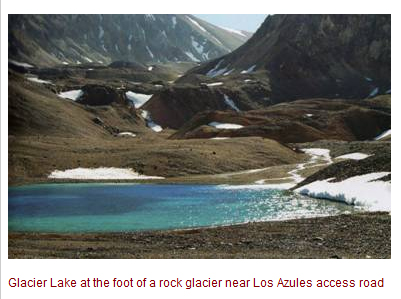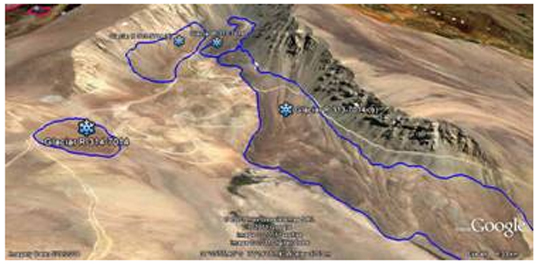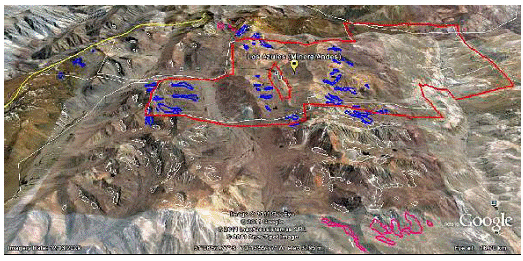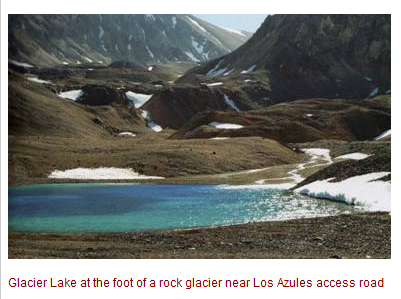Esta entrada también está disponible en: Spanish
 July 30th 2012. San Juan, Argentina – The Canadian government’s Extractive Sector Ombudsman decided to formally admit a Request for Review brought by environmental groups focused on McEwen Mining’s (NYSE: MUX; TSX: MUX) impacts to glaciers by its Los Azules project in Argentina.
July 30th 2012. San Juan, Argentina – The Canadian government’s Extractive Sector Ombudsman decided to formally admit a Request for Review brought by environmental groups focused on McEwen Mining’s (NYSE: MUX; TSX: MUX) impacts to glaciers by its Los Azules project in Argentina.
The original complaint (called a “Request for Review”) filed earlier this month by the Center for Human Rights and Environment (CEDHA) and Fundación Ciudadanos Independientes (FUCI), both local environmental organizations in Argentina, says McEwen falsely claims on its website that no ice glaciers are present in the Los Azules project area, McEwen Mining’s most important copper project in Latin America. The complaint also calls for McEwen to recognize glacier presence at the project site and adopt a glacier protection policy and adhere to it, which would require that McEwen repair any past damage to glaciers and avoid all future glacier impact.
Drilling during exploratory work by the project has taken place on permafrost (frozen grounds) which is protected by Argentine law, and at least one of Los Azules’ projected waste pile sites would coincide with an existing glacier. These project design elements must be changed before the project can be allowed to move forward. The following images show an exploratory mining road at Los Azules running straight through subsurface rock glaciers (outlined in blue).

In May of 2012, CEDHA published an extensive report showing more than 200 glaciers in the project vicinity, some directly impacted by McEwen’s present operations. The information had been made available to Minera Andes (the local affiliate and past owner of the project). Minera Andes had originally engaged constructively with CEDHA to address the environmental group’s findings and invited the organization to visit the project site. That predisposition changed following McEwen’s acquisition of the project in January of this year, and the programmed site visit was first stalled and then canceled. At the same time however, the company posted on its website that no ice glaciers were present in the project area. That drove CEDHA to file the Request for Review to the Canadian government.
CEDHA was instrumental in helping get Argentina’s National Glacier Protection Act passed in 2010, which bans mining in glacier areas, and has since been carrying out what it calls its “democratizing glaciers initiative” educating communities, policy makers and corporate actors about glaciers and their eco-systemic value for dry mountain climates like those found in the Argentine Andes. This includes identifying mining projects, like Los Azules, which are in glacier areas.
CEDHA aims to make glacier research and findings viewable and easily accessible to stakeholders, using publicly available programs such as Google Earth. What makes this case very special, says CEDHA, is that the ice glaciers (called “rock glaciers”) at Los Azules are actually sub-surface ice; that is, they are hard to see as no ice or even snow is visible in satellite images. You could be standing on a glacier and not even know it as the ice could be several meters below the surface of the earth. However, certain characteristics such as recurring flow patterns can help a viewer spot the massive ice bodies. A result of this particular characteristic is that many mining companies have totally ignored ice glacier presence in this area of Argentina. Glacier resources are critical to the mountain ecosystems and river flows, and to agricultural and human water consumption.
Many exploratory mining roads have plowed right through meters of critical ice reserves, potentially causing serious disequilibrium of protected ice which could lead to a total collapse of the glacier ecosystem or glaciosystem. Rock glaciers can hold enormous quantities of water in reserve, especially important for warm and arid years. This is why they are protected as strategic reserves and water basin regulators by the National Glacier Protection Act. Below is an image of the Los Azules project site with some of the more than 200 glaciers in the project area.

The National Glacier Protection Act was passed unanimously in 2008 but was vetoed by President Fernandez de Kirchner of Argentina following pressure by Barrick Gold. A national campaign helped get the law back in 2010 and this time it was approved by Congress by a slim margin. The president kept her promise that she would not veto the law if it passed a second time.
Barrick Gold (Pascua Lama and Veladero projects) and Xstrata Copper (El Pachón and Filo Colorado projects) subsequently attacked the law in Argentine courts and received a temporary suspension of the law in San Juan Province so that they could move forward with their projects, which are also in glacier areas. However, the Argentine Supreme Court overturned the suspension recently, making the law fully applicable for Barrick and for other companies extracting or exploring for minerals in the high and cold Andes Mountains, including McEwen.
Just days after the Barrick verdict, another court case suspended Osisko’s (TSX: OSK) Famatina project for not having complied with the
National Glacier Protection Act, mandating that the project await a national glacier survey and carry out any necessary glacier impact reports – the same reports CEDHA and FUCI are claiming are necessary before Los Azules is allowed to move forward. That court case was based on a CEDHA report showing more than 400 glaciers in La Rioja Province, following claims by the governor that no glaciers were present in the province. In that report, CEDHA revealed surprising evidence, such as the image below showing how the province’s largest glacier, El Potro, had been entirely concessioned for mining exploration to NGEX Resources of Canada. The mining project name ironically is El Potro, the name of the glacier! The environment minister of La Rioja spoke on national television recently indicating that he was not sure if El Potro was a glacier, showing just how little public officials know about their glacier reserves.
 The Request for Review in the McEwen case, brought by CEDHA and FUCI to the CSR Ombudsman for the Extractive Sector of Canada, an office introduced by the Canadian government to try to improve corporate due diligence in the mining sector, now moves into a mediation phase during which the environmental groups and McEwen will have to sort out differences and attempt to reach a mediated solution to the conflict.
The Request for Review in the McEwen case, brought by CEDHA and FUCI to the CSR Ombudsman for the Extractive Sector of Canada, an office introduced by the Canadian government to try to improve corporate due diligence in the mining sector, now moves into a mediation phase during which the environmental groups and McEwen will have to sort out differences and attempt to reach a mediated solution to the conflict.
Both CEDHA and FUCI remain open to constructive dialogue with McEwen but request that the CSR Ombudsman engage the company to recognize glacier impacts and cease operations until a proper inventory and impact study is carried out.
For more information:
Jorge Daniel Taillant
Phone: +54 9 351 507 8376
Link to complaint filed against McEwen to the CSR Counsellor
https://center-hre.org/wp-content/uploads/2012/07/Request-for-Review-McEwen-CEDHA.pdf
link to full glacier impact report for McEwen’s Los Azules project:
https://center-hre.org/wp-content/uploads/2012/07/Glaciar-Impact-Report-Los-Azules.pdf
link to news on Supreme Court’s overturning of Barrick’s suspension of glacier law:
https://center-hre.org/?p=10828&lang=en
link to news on revocation of Osisko’s Famatina exploration permit:
https://center-hre.org/?p=10987&lang=en
Downloading Instagram Reels is a great way to get access to the newest and most exciting short-form videos on the market. Created with users in mind, reels allow creatives to flex their creative muscles, share unique content with friends, or even discover an up-and-coming artist. With download reels from Instagram you can access your favorite videos offline, easy and quickly

